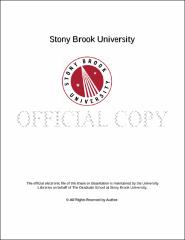| dc.identifier.uri | http://hdl.handle.net/11401/76594 | |
| dc.description.sponsorship | This work is sponsored by the Stony Brook University Graduate School in compliance with the requirements for completion of degree. | en_US |
| dc.format | Monograph | |
| dc.format.medium | Electronic Resource | en_US |
| dc.language.iso | en_US | |
| dc.publisher | The Graduate School, Stony Brook University: Stony Brook, NY. | |
| dc.type | Thesis | |
| dcterms.abstract | Title: The Bacterial Colonization of Commonly Used Dental Implant Occluding Materials.  Purpose: To determine the bacterial communities inhabiting commonly used materials intended to block/occlude the screw access channel of dental implant crowns/restorations. To aid in the prevention of peri-implantitis, a material that harbors less pathogenic red and orange complex microbes would be potentially beneficial when microleakage is occurring. A superior material for the purpose of the occlusion of screw access channels in implant-supported prostheses is a material that may provide a surface to which bacteria may not colonize. The choice of an occluding material that is less favorable for bacterial growth, particularly red and orange complex growth, will be more advantageous to use in clinical practice and may assist in the prevention of peri-implant pathology. Materials/Methods: This was a randomized controlled clinical trial, which included eight subjects. Four commonly used materials (PTFE tape, PVS, Cotton, Foam) were placed as test materials in the dental implant access cylinders giving a total of 32 samples. Materials were sealed and recovered after a minimum of six months. DNA was extracted from the samples and the bacterial community composition was analyzed by high-throughput sequencing of 16S rRNA amplicons. The contribution of particular species, genera, and bacterial complexes to the bacterial community present in each sample was calculated as percent of total sequences. A post-hoc Tukey’s HSD test at a significance level of α=0.05 was applied to determine if differences in bacterial community composition among patients or materials were statistically significant. Results: A total of 286 different genera and 492 different species were recorded in a total of 1,862,900 sequences. On average each sample generated 58,215 sequences. The most abundant microbes, based on genus, were Lactobacillus(26.48% of total sequences), Atopobium(10.10%), Streptococcus (5.22%) and Selenomonas(3.61%), none belonging to the classic pathogenic Red and Orange Complexes. The most abundant species was Atopobium spp., also not belonging to the pathogenic microbial complexes. There were a total of six microbial species not found in the colored complexes that were affected by the material used, but no one material seemed to be better than the other three in preventing red and orange microbial colonization. There was no significant difference in colored complexes amongst materials. This demonstrates that the microbes were not affected by the material used, but rather more influenced by the subject. Conclusions: 1- There were no statistically significant differences in bacterial colonization amongst the test materials. The choice of an occluding material would therefore be based on clinical judgment. 2- There were a total of six microbial species not present in the “colored†complexes of Socransky and Haffajee that were affected by the occluding materials. These six microbial species were Atopobium spp., Bilophila wadsworthia, Erysipelothrix spp., Haemophilus parainfluenzae, Rheinheimera spp. and Shuttleworthia satelles. 3- Atopobium spp., Selenomonas spp. and Fusobacterium spp., were amongst the most prevalent microbial species present in the materials tested. | |
| dcterms.available | 2017-09-20T16:50:45Z | |
| dcterms.contributor | Simon, Marcia | en_US |
| dcterms.contributor | Walker, Stephen | en_US |
| dcterms.contributor | Collier, Jackie | en_US |
| dcterms.contributor | Carrion, Julio A | en_US |
| dcterms.contributor | Gu, Ying | en_US |
| dcterms.contributor | Iacono, Vincent. | en_US |
| dcterms.creator | Katz, Brandon G. | |
| dcterms.dateAccepted | 2017-09-20T16:50:45Z | |
| dcterms.dateSubmitted | 2017-09-20T16:50:45Z | |
| dcterms.description | Department of Oral Biology and Pathology. | en_US |
| dcterms.extent | 55 pg. | en_US |
| dcterms.format | Application/PDF | en_US |
| dcterms.format | Monograph | |
| dcterms.identifier | http://hdl.handle.net/11401/76594 | |
| dcterms.issued | 2015-12-01 | |
| dcterms.language | en_US | |
| dcterms.provenance | Made available in DSpace on 2017-09-20T16:50:45Z (GMT). No. of bitstreams: 1
Katz_grad.sunysb_0771M_12418.pdf: 1767789 bytes, checksum: 76c4c096ef4ed24ad041a74d464462bb (MD5)
Previous issue date: 1 | en |
| dcterms.publisher | The Graduate School, Stony Brook University: Stony Brook, NY. | |
| dcterms.subject | Dental, Implant, Malodor, Microbiology, Occluding, PTFE | |
| dcterms.subject | Dentistry | |
| dcterms.title | The Bacterial Colonization of Commonly Used Dental Implant Occluding Materials. | |
| dcterms.type | Thesis | |

